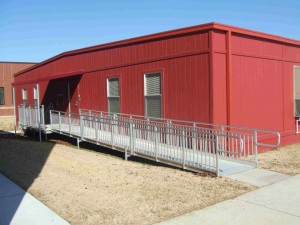 OSHA compliant walkways serve two purposes on the job: they protect workers from injuries, and they protect pedestrians from being injured by nearby workers, falling objects and construction activity. REDD Team can help you comply with the regulations and avoid the hazards associated with walking/working surfaces on your job site.
OSHA compliant walkways serve two purposes on the job: they protect workers from injuries, and they protect pedestrians from being injured by nearby workers, falling objects and construction activity. REDD Team can help you comply with the regulations and avoid the hazards associated with walking/working surfaces on your job site.
REDD Team manufactures some of the finest American-made industrial stairways and work platforms on the market today. Our products are highly valued for the construction, modular building, oil-shale drilling and military industries, as well as aerospace and many other applications. They are engineered with the finest aluminum and stainless steel components to meet most code requirements and standards, such as OSHA, ADA, IBC, SBC, BOCA, and others as required.
OSHA Requirements for Walking/Working Surfaces
OSHA mandates a wide variety of safety standards for walking/working surfaces, and many of them relate to scaffolding. Most other passageways that are elevated above ground level, such as a pedestrian walkway between buildings on a construction site, are generally called “runways.”
We’ve provided a summary below of the regulations that pertain to non-scaffolding walkways and runways, but be sure to read the complete set of OSHA standards to make certain your workplace is in compliance.
When moving equipment or falling materials pose a hazard to pedestrians, open-sided walkways should be protected as follow to allow them to pass safely:
- Open-sided platforms that are 4 feet or more above the adjacent floor or ground level must have standard guard railing on all open sides except where there is an entrance to a ramp, stairway, or fixed ladder;
- Regardless of height, open-sided walkways, platforms, or runways above or adjacent to dangerous equipment and other hazards must be guarded with a standard railing and toe board;
- A standard railing must have a top rail, intermediate rail, and posts, and a vertical height of 42 inches from the upper surface of the top rail to the floor, platform, runway, or ramp level;
- Top rails must be strong enough to withstand at least 200 pounds of pressure;
- Runways/walkways used exclusively for special purposes (such as oiling, shafting or filling tank cars) may omit the railing on one side provided that the falling hazard is minimized by using a runway at least 18 inches wide;
- OSHA prohibits walkways from having slopes steeper than 20 degrees, or one vertical unit per three horizontal units.
- Walkways with a slope of at least one vertical unit per eight horizontal units must have cleats to protect workers from slipping. The cleats must not be more than 14 inches apart and should be securely fastened to the walkway surface.
Why Choose Aluminum Walkways?
Some of the advantages of aluminum walkways include:
- Durability and light weight
- High strength to weight ratio (typically built from 6000 series aluminum alloy with 6061-T6 for structural strength)
- Slip-resistant for superior safety
- Easy installation with slip-in rails and legs
- Virtually maintenance-free
- Less expensive than standard brick and mortar walkway solutions
- Rust and corrosion-resistant
- Engineered to withstand high winds
- Naturally attractive
- Needs no finish coating or paint (steel, which has to be painted, can be more expensive than aluminum for this reason)
- Easily dismantled, relocated and reassembled in different locations
- Environmentally friendly; 100% of the material can be recycled repeatedly
Call REDD Team at (800) 648-3696 for more information about the OSHA standards for walkways, ramps, stairs and platforms, and check out our catalog of aluminum access products that will keep your workplace safe.

